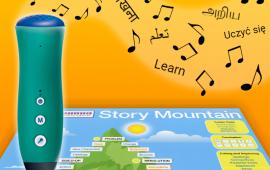Bon Appetit – Our Tactile Talking Menus Help You Sound Things Out
You know we all experience the world through our five main senses, and that everyone experiences it slightly differently, and you’ve almost certainly come across the saying “a picture paints a thousand words”. Did you know, however, that over 50% of the cortex, the surface of our brains, is dedicated to processing the visual signals around us?
So where does that leave you if you are blind, or visually impaired? Since the world is mainly designed with the assumption that everyone can see to the same extent, trying to navigate the world without sight can be extremely hard work. The simplest and most joyous of events, like enjoying a meal out at a restaurant with your family and friends, can become monumentally and unnecessarily difficult. While many restaurant staff do their best to assist those who need extra support, with hearing loops for example, it is not unknown for servers to refuse to read out items on a menu to someone with a visual impairment.
Even if you have perfect 20/20 vision, there are times when an auditory explanation can be very helpful. You might, for instance, listen to a description of the ingredients, or one of the 14 allergens that must be declared in the UK. This can be extremely helpful when deciding what to eat – or indeed, what not to eat. And if you’re in a bilingual situation, say, where someone doesn’t understand the language on the menu, or can’t read it, then sound can also be extremely helpful.
The same applies if you have hearing issues, and you’re in a busy environment. If you’ve ever been sat next to the espresso machine in a busy coffee shop, you know how hard you might have to concentrate to work out what the servers are asking you. Being able to repeat information helps you to understand what is going on around you, while there are studies which show that for many blind and partially sighted individuals, their sense of touch is enhanced.
Using our DiscoveryPEN technology through a PENpal, together with sound spots, up to 60 minutes of explanation, information or instruction per sound spot can be recorded quickly and simply. If the menu changes, you can simply re-record the information and reuse. Our technology is suitable for use in restaurants, canteens, residential and care settings and SEN environments – anywhere, in fact, where you need to improve accessibility.
Of course you aren’t only limited to recording menu information. You can use the sound spots to record any additional information you like, in any language, making it ideal for use in a bilingual or multilingual setting. Stay tuned for some of the other exciting ways we are using the technology to help make the world a little more accessible for the blind and those with visual impairments.
If you have just a few minute to spare, you can see our Tactile Talking menus in action for yourself.
References
All references were successfully accessed on 8 November 2019.
So where does that leave you if you are blind, or visually impaired? Since the world is mainly designed with the assumption that everyone can see to the same extent, trying to navigate the world without sight can be extremely hard work. The simplest and most joyous of events, like enjoying a meal out at a restaurant with your family and friends, can become monumentally and unnecessarily difficult. While many restaurant staff do their best to assist those who need extra support, with hearing loops for example, it is not unknown for servers to refuse to read out items on a menu to someone with a visual impairment.
Even if you have perfect 20/20 vision, there are times when an auditory explanation can be very helpful. You might, for instance, listen to a description of the ingredients, or one of the 14 allergens that must be declared in the UK. This can be extremely helpful when deciding what to eat – or indeed, what not to eat. And if you’re in a bilingual situation, say, where someone doesn’t understand the language on the menu, or can’t read it, then sound can also be extremely helpful.
The same applies if you have hearing issues, and you’re in a busy environment. If you’ve ever been sat next to the espresso machine in a busy coffee shop, you know how hard you might have to concentrate to work out what the servers are asking you. Being able to repeat information helps you to understand what is going on around you, while there are studies which show that for many blind and partially sighted individuals, their sense of touch is enhanced.
Using our DiscoveryPEN technology through a PENpal, together with sound spots, up to 60 minutes of explanation, information or instruction per sound spot can be recorded quickly and simply. If the menu changes, you can simply re-record the information and reuse. Our technology is suitable for use in restaurants, canteens, residential and care settings and SEN environments – anywhere, in fact, where you need to improve accessibility.
Of course you aren’t only limited to recording menu information. You can use the sound spots to record any additional information you like, in any language, making it ideal for use in a bilingual or multilingual setting. Stay tuned for some of the other exciting ways we are using the technology to help make the world a little more accessible for the blind and those with visual impairments.
If you have just a few minute to spare, you can see our Tactile Talking menus in action for yourself.
References
All references were successfully accessed on 8 November 2019.
- Amarpreet, K. (2015), How do our brains reconstruct the visual world?, The Conversation, 5 November 2015, http://theconversation.com/how-do-our-brains-reconstruct-the-visual-world-49276
- Food Allergy and Intolerance (2018), Food Standards Agency, 4 September 2018, https://www.food.gov.uk/safety-hygiene/food-allergy-and-intolerance
- Groeger, L. (2012), Making Sense of the World, Several Senses at a Time, Scientific American, 28 February 2012, https://www.scientificamerican.com/article/making-sense-world-sveral-senses-at-time/
- Hagen, S. (2012), The Mind’s Eye, Rochester Review 74(4), March-April 2012, https://www.rochester.edu/pr/Review/V74N4/pdf/0402_brainscience.pdf
- Society for Neuroscience (2010), "Blind people perceive touch faster than those with sight." ScienceDaily, 28 October 2010. https://www.sciencedaily.com/releases/2010/10/101026172021.htm
Related Posts
-
What is Selective Mutism?
-
Chinese New Year: Year of the Pig
-
Dual Language Books - A Whistle Stop Tour
Mantra Lingua dual language Books: some questions
-
Language sponges of the world unite – how effective are bilingual books in early years education?
-
Autumn Celebrations: Day of the Dead, Diwali and Halloween
-
Tiny Happy People - Beautifully Bilingual
-
Once Upon a Storytime
-
‘Brain breaks’ for new arrivals – art activities to help transitions to a new school
-
Do you know your ELGs from your EYFS? How Mantra Lingua can help Early Years Literacy
-
Bon Appetit – Our Tactile Talking Menus Help You Sound Things Out













